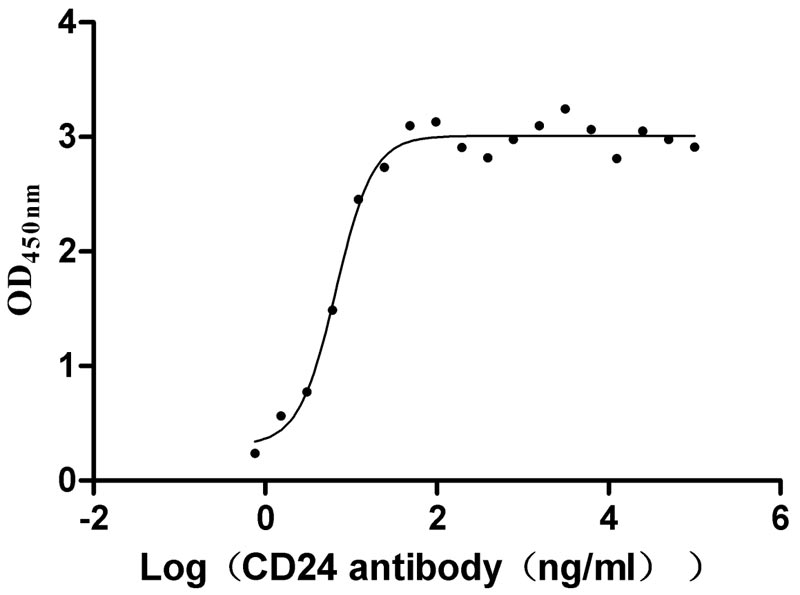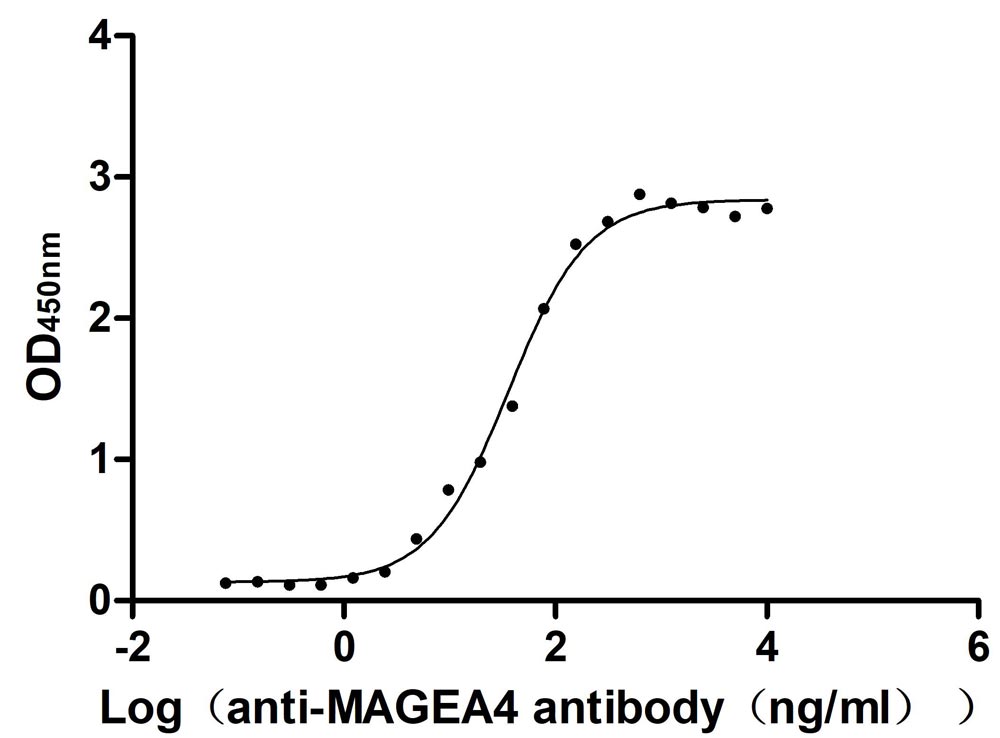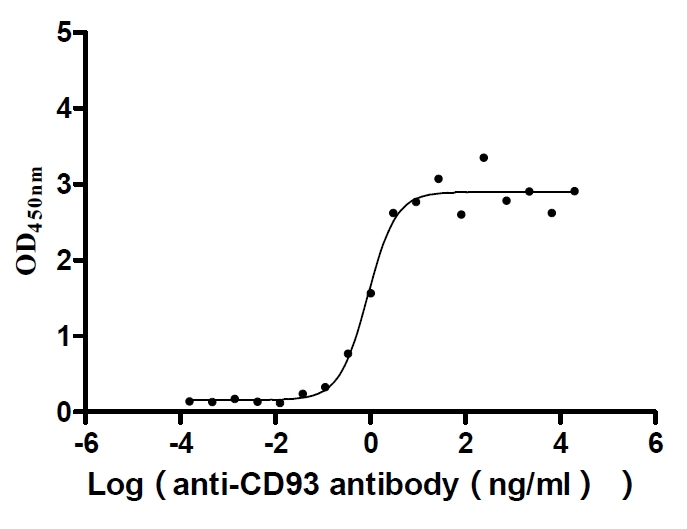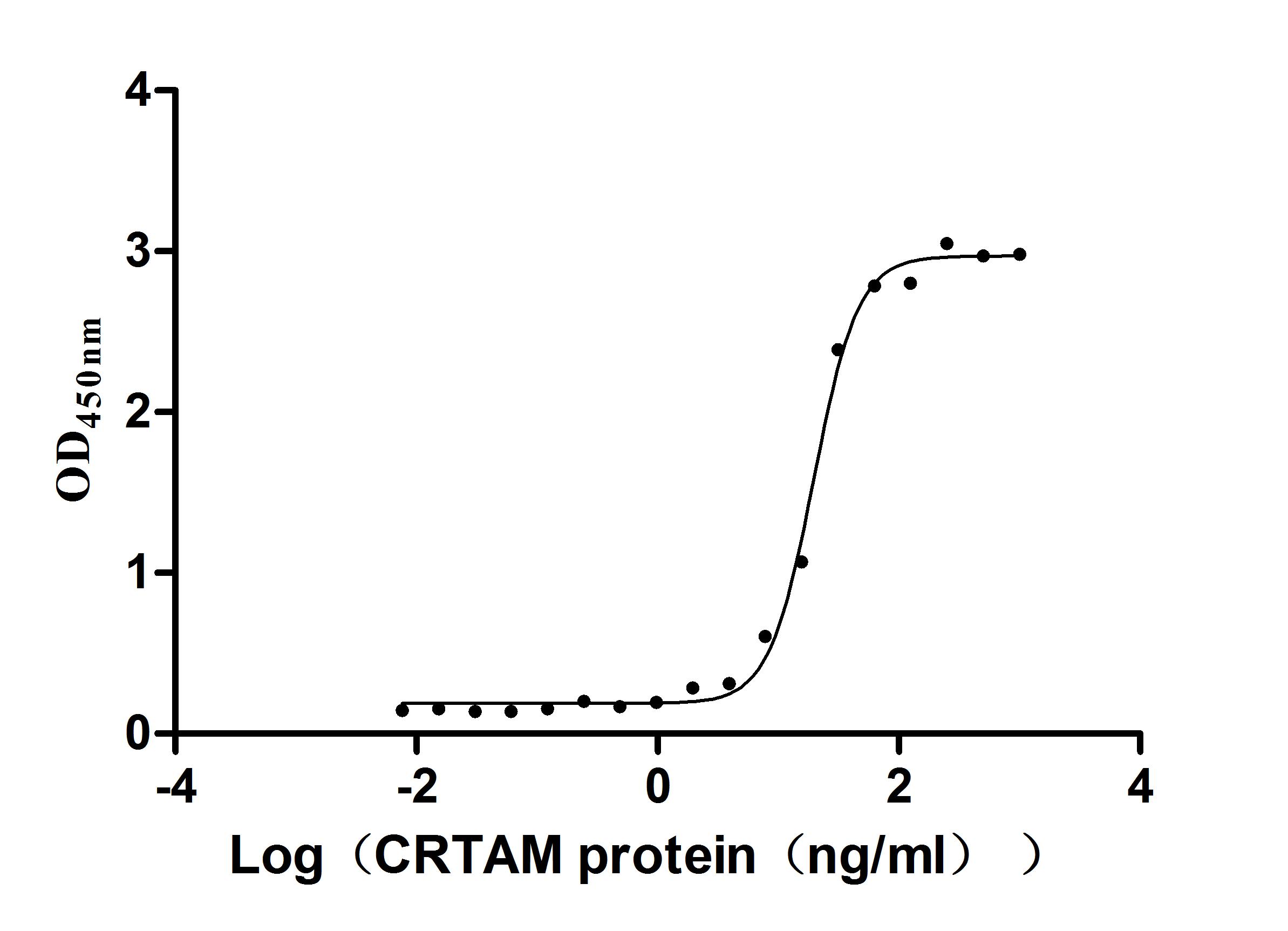Recombinant Human C-C chemokine receptor type 1 (CCR1), partial
In Stock-
貨號:CSB-EP004839HU1
-
規格:¥1536
-
圖片:
-
其他:
產品詳情
-
純度:Greater than 85% as determined by SDS-PAGE.
-
基因名:
-
Uniprot No.:
-
種屬:Homo sapiens (Human)
-
蛋白長度:Partial
-
來源:E.coli
-
分子量:18.9 kDa
-
表達區域:306-355aa
-
氨基酸序列ERFRKYLRQLFHRRVAVHLVKWLPFLSVDRLERVSSTSPSTGEHELSAGF
Note: The complete sequence may include tag sequence, target protein sequence, linker sequence and extra sequence that is translated with the protein sequence for the purpose(s) of secretion, stability, solubility, etc.
If the exact amino acid sequence of this recombinant protein is critical to your application, please explicitly request the full and complete sequence of this protein before ordering. -
蛋白標簽:N-terminal 6xHis-SUMO-tagged
-
產品提供形式:Liquid or Lyophilized powder
Note: We will preferentially ship the format that we have in stock, however, if you have any special requirement for the format, please remark your requirement when placing the order, we will prepare according to your demand. -
緩沖液:If the delivery form is liquid, the default storage buffer is Tris/PBS-based buffer, 5%-50% glycerol. If the delivery form is lyophilized powder, the buffer before lyophilization is Tris/PBS-based buffer, 6% Trehalose.
-
復溶:We recommend that this vial be briefly centrifuged prior to opening to bring the contents to the bottom. Please reconstitute protein in deionized sterile water to a concentration of 0.1-1.0 mg/mL.We recommend to add 5-50% of glycerol (final concentration) and aliquot for long-term storage at -20℃/-80℃. Our default final concentration of glycerol is 50%. Customers could use it as reference.
-
儲存條件:Store at -20°C/-80°C upon receipt, aliquoting is necessary for mutiple use. Avoid repeated freeze-thaw cycles.
-
保質期:The shelf life is related to many factors, storage state, buffer ingredients, storage temperature and the stability of the protein itself.
Generally, the shelf life of liquid form is 6 months at -20°C/-80°C. The shelf life of lyophilized form is 12 months at -20°C/-80°C. -
貨期:3-7 business days
-
注意事項:Repeated freezing and thawing is not recommended. Store working aliquots at 4°C for up to one week.
-
Datasheet & COA:Please contact us to get it.
相關產品
靶點詳情
-
功能:Receptor for a C-C type chemokine. Binds to MIP-1-alpha, MIP-1-delta, RANTES, and MCP-3 and, less efficiently, to MIP-1-beta or MCP-1 and subsequently transduces a signal by increasing the intracellular calcium ions level. Responsible for affecting stem cell proliferation.
-
基因功能參考文獻:
- The polymorphism of CCR1 rs3733096 and CCL5 rs3817656 are associated with spontaneous clearance of hepatitis C virus in Chinese Han population. PMID: 29703961
- Data suggest that CCR1 gene may be a putative marker of molecular activity of Crohn's disease. PMID: 29556615
- Results reveal that CCR1 expression is positively correlated with OPN expression in hepatocellular carcinoma cells, and the patients with high levels of both OPN and CCR1 have the most dismal prognosis. Study also, shows that steopontin upregulates CCR1 in HCC cells and, that CCR1 is essential for osteopontin-induced HCC metastasis. PMID: 29285854
- Expression of CCR1 was measured in retrospective clinical specimens of colorectal cancer lung metastases. CCR1+ cells accumulated around the CCL15-positive colorectal cancer cells in the lung, but few around the CCL15-negative ones. PMID: 27492974
- during renal transplantation, CD4+ and CD8+ T cells expressing CCR1 were increased in patients who developed renal allograft dysfunction PMID: 27234431
- MIP-1alpha receptor antagonism can significantly reduce T cell migration to the secreted factors from Oesophagogastric adenocarcinoma omentum and liver. PMID: 27046081
- These data suggest that CCR1/CCR2B could be involved in clearing EBV-infected latency III B cells in immunocompetent individuals via directing the migration of these cells and attracting the chemokines-expressing immune cells. PMID: 28892735
- Data suggest that the interplay between CCR1 upregulation and inactivation of CXCR4 signaling (the CCR1/CXCR4 axis) drives the egress of multiple myeloma PCs from the bone marrow, leading to disease dissemination. PMID: 28855206
- Basophil migration into skin lesions of Systemic Lupus Erythematosus patients were observed, but not in normal skin tissue. This migration was related to the upregulation of chemokine receptors CCR1 and CCR2 on basophils. PMID: 28954264
- Study indicates that two distinct micro-environmental factors, CD40L and Mphis, signal via CCR1 to induce AKT activation resulting in translational stabilization of MCL-1, and hence can contribute to CLL cell survival. PMID: 28192408
- CCL15 activation of CCR1 plays critical roles in hepatocellular carcinoma metastasis. PMID: 26501423
- CCL15-positive primary colorectal cancers recruited approximately 2.2 times more numbers of CCR1(+) cells. PMID: 26341919
- The residues on the N-loop and beta-sheets of MIP-1a are close to both CCR1 and CCR5, and those in the C-terminal helix region are close to CCR5. PMID: 26472202
- Results highlight the potential role of CCR genes in narcolepsy and support the hypothesis that patients with narcolepsy have impaired immune function. PMID: 25986216
- CCR1, KLRC4, IL12A-AS1, STAT4, and ERAP1 are bona fide susceptibility genes for Behcet's disease. PMID: 26097239
- This study reveled that CCR1 having a central role in the bipolar disease and schizophrenia manifestation. PMID: 25487697
- Identifying bias in CCR1 antagonists using radiolabelled binding, receptor internalization, beta-arrestin translocation and chemotaxis assays PMID: 24990525
- These results suggest that increased CC-chemokine receptor expression may play a role in the pathogenesis of adenomyosis. PMID: 24599574
- Our results confirm the strong influence of previous immunity in subsequent dengue infections, and confer a possible pathogenic role to CCR1 and CCL3 in dengue disease and a possible protective role for CCL5, probably through CCR5 interaction. PMID: 24157267
- cross-desensitization of CCR1 by FPR1 was associated with CCR1 phosphorylation and moderate reduction of CCR1 cell-surface expression. In contrast, CCR2 was not phosphorylated or internalized after FPR1 activation. PMID: 24778447
- Data suggest that CCL13 binds to several chemokine receptors (CCR1, CCR2, and CCR3), allowing CCL13 to elicit different effects on its target cells of the immune system. CCL13/CCR1 signal transduction is key step in asthma progression. [REVIEW] PMID: 23846739
- the interaction of CCR1 with CCL5 caused by increased expression of CCR1 promotes invasion of PC3 Castration-refractory prostate cancer cells by increasing secretion of MMPs 2 and 9 and by activating ERK and Rac signaling. PMID: 23876400
- CCR1.beta-arrestin-2 complex may be related to a potential scavenging function of the receptor, which may be important for maintenance of chemokine gradients and receptor responsiveness in complex fields of chemokines during inflammation. PMID: 24056371
- Increased expression of CCR1 and CCR3 chemokine receptors may, in accord with various chemokines, contribute to the pathogenesis of nasal polyposis. PMID: 23054685
- Cigarette smoking could increase the expression of CCR1 on the inflammatory cells. Both CCR1 and CCR5 expressions on the inflammatory cells in induced sputum could be associated with COPD severity. PMID: 23217400
- Elevated immunoreactivity of RANTES and CCR1 correlate with the severity of stages and dysmenorrhea in women with deep infiltrating endometriosis. PMID: 23219091
- Signaling via CCL5/CCR1 axis triggers migration of adipose tissue derived stromal cells, activates ERK and AKT kinases, stimulates NFkappaB transcriptional activity and culminates in increased proliferation of CCR1(+) cells. PMID: 23276697
- These findings suggest that the increased expression of CCL3, CCR1, and CCR5 may influence the immune response in RAS by T(H)1 cytokine polarization. PMID: 22727097
- The expression of chemokine receptor CCR1 on the immune cells in orbital tissue of thyroid associated ophthalmopathy patients is elevated. PMID: 22650026
- The CCL3-CCR1 axis may play an important role in promoting macrophage infiltration in degenerated, herniated discs. PMID: 23233369
- CCR1-mediated STAT3 tyrosine phosphorylation and CXCL8 expression in THP-1 macrophage-like cells involve pertussis toxin-insensitive Ga14/16 signaling and IL-6 release. PMID: 23125416
- ten SNPs, located in 3'UTR, 5'UTR in CCR1 or 5'UTR in CCR3, were significantly associated with Behcet's disease PMID: 22829007
- Data show parathyroid hormone-related protein (PTHrP) and macrophage inflammatory protein-1alpha (MIP-1alpha) exert antitumor effect presumably by increasing sensitivity to apoptotic signals through modulation of transcription and apoptosis factors in T-cells. PMID: 21942940
- a bis-quinoline compound, (7-chloro-N-(4-(7-chloroquinolin-4-ylamino)butyl)quinolin-4-amine; RE-660) has C-C chemokine receptor type 1 (CCR1)-agonistic properties PMID: 22104149
- The expression of chemokine receptor CCR1 is higher in the orbital fibroblasts of patients with thyroid associated ophthalmopathy than in normal controls. PMID: 22007486
- TLR2 negatively regulates CCR1, CCR2, and CCR5 on blood monocytes by activating chemokine-dependent down-modulation and providing a molecular mechanism for inhibiting monocyte migration after pathogen recognition. PMID: 21148810
- Above median expression of CXCR2, CXCR3 and CCR1 in the tumour islets is associated with increased survival in non-small cell carcinoma, and expression of CXCR3 correlates with increased macrophage and mast cell infiltration in the tumour islets. PMID: 20429924
- CCR1 antagonist, BX471, did not significantly alter ICAM-3 expression in relapsing-remitting multiple sclerosis patients. PMID: 20086017
- These data suggest that CCR1 may be useful for lymphoma classification and support a role for chemokine signaling in the pathogenesis of hematolymphoid neoplasia. PMID: 20154287
- CCR1 were genes activated in late endometrial endometrioid carcinoma (stages III-IV). PMID: 20015385
- The expression CCR1 in colorectal carcinoma is correlated with lymph node metastasis. PMID: 19664396
- agonistic effect of truncated leukotactin-1 on receptor activity PMID: 11832479
- We determined that human serum contains a molecule that suppresses RANTES (CCL5) binding to endothelial cells, PBMC and CHO cells. PMID: 11920567
- CCR1, CCR6, and CXCR6 are preferentially expressed by the low cytokine-producing CD8 and CD4(-)CD8(-) subsets of natural killer T-cells. PMID: 12070001
- chronic hepatitis C, but not hepatitis B, infection alters surface expression of CCR1 and CCR5 in T cells, resulting in lower CC chemokine responsiveness. PMID: 12085329
- Selective CCL5/RANTES-induced mast cell migration through interactions with chemokine receptors PMID: 12270118
- Potential interaction between this protein and it ligand, CCL3 is induced by endogenously produced interleukin-1 in human hepatomas. PMID: 12651617
- Efficient leukocyte arrest in flow but not transmigration may thus require the presentation of RANTES oligomers to bridge surface-bound RANTES and CCR1. PMID: 12763925
- Eosinophil CCR1 expression is non-normally distributed in atopics, although higher CCR1 expression levels are not predictive of a diagnosis of atopy or atopic disease. PMID: 12794150
- Trophoblasts acquire CCR1 as they differentiate to an invasive phenotype at the villus-anchoring sites. PMID: 14530297
顯示更多
收起更多
-
亞細胞定位:Cell membrane; Multi-pass membrane protein.
-
蛋白家族:G-protein coupled receptor 1 family
-
組織特異性:Widely expressed in different hematopoietic cells.
-
數據庫鏈接:
Most popular with customers
-
Recombinant Human CD48 antigen (CD48) (Active)
Express system: Mammalian cell
Species: Homo sapiens (Human)
-
Recombinant Human Leukemia inhibitory factor receptor (LIFR), partial (Active)
Express system: Mammalian cell
Species: Homo sapiens (Human)
-
Recombinant Mouse Desmoglein-3 (Dsg3), partial (Active)
Express system: Mammalian cell
Species: Mus musculus (Mouse)
-
Recombinant Human HLA class II histocompatibility antigen gamma chain (CD74), partial (Active)
Express system: Mammalian cell
Species: Homo sapiens (Human)
-
Recombinant Human Signal transducer CD24 (CD24)-Nanoparticle (Active)
Express system: Mammalian cell
Species: Homo sapiens (Human)
-
Recombinant Human Melanoma-associated antigen 4 (MAGEA4) (Active)
Express system: Mammalian cell
Species: Homo sapiens (Human)
-
Recombinant Human Complement component C1q receptor (CD93), partial (Active)
Express system: Mammalian cell
Species: Homo sapiens (Human)
-
Recombinant Human Cell adhesion molecule 1 (CADM1), partial (Active)
Express system: Mammalian cell
Species: Homo sapiens (Human)

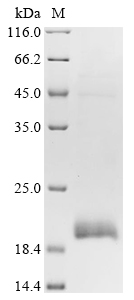

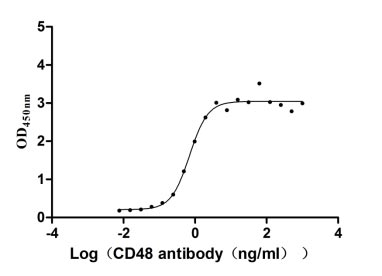

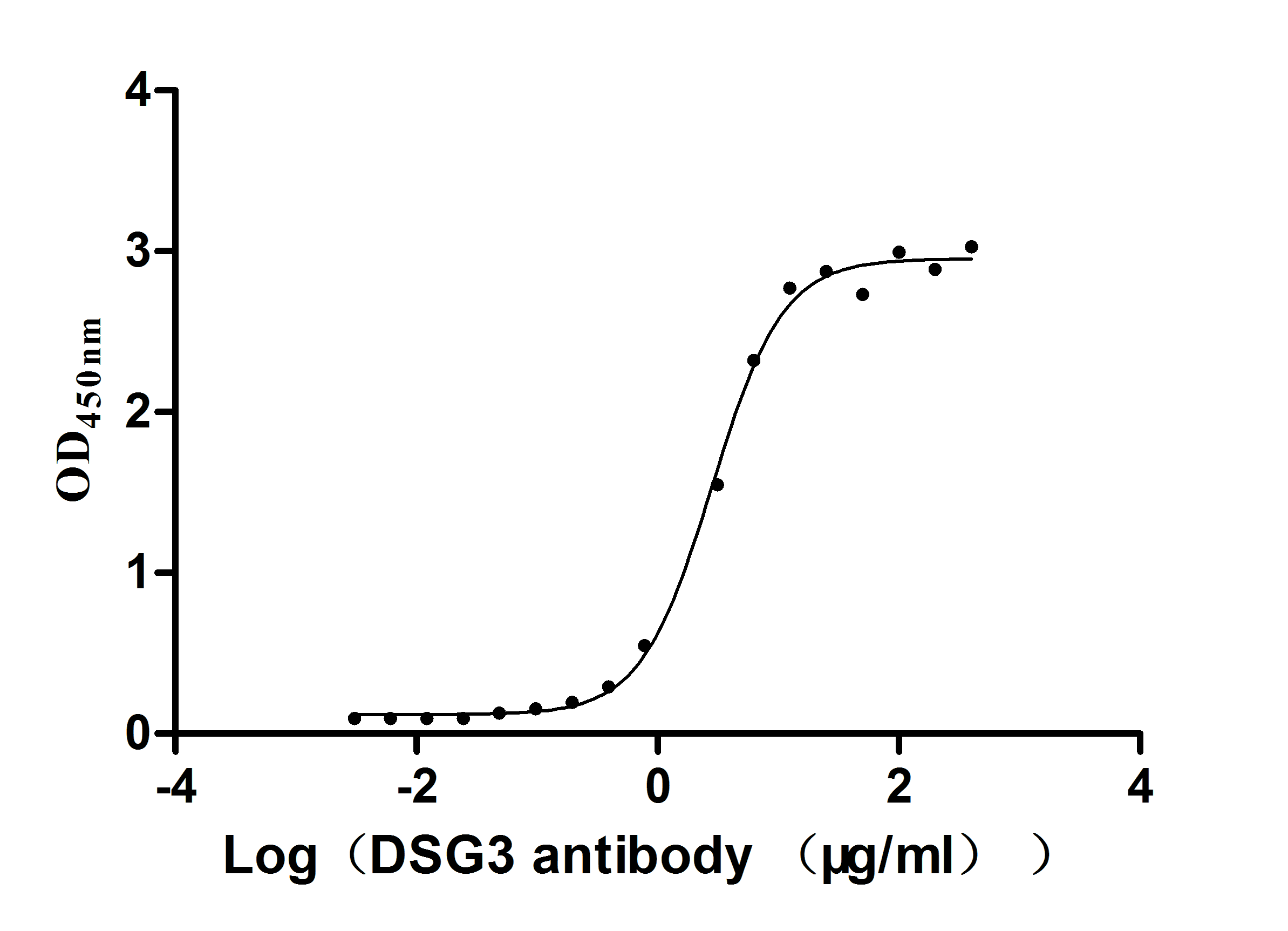
-AC1.jpg)
